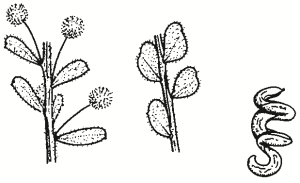Family:
Fabaceae
Acacia acinacea
Gold-dust Wattle
(syn. A. rotundifolia)
Other Names:

Name Origin:
acinacea — curved, sword-like, possibly referring to coiled legumes or seed-bearing fruit.
Regional Subspecies:
Occurrence:
Regional:
Common west of the Olympic Highway.
Australia:
NSW, Vic, SA.
Habitat:
Woodland. A range of soils, chiefly sand.
Habit:
Small spreading shrub 30 cm to 2 m high with arching branches, angled or flattened branchlets and hairy ‘leaves’.
Site Preference:
Well-drained soil in full or partial sun. Frost and drought tolerant. Resents poor drainage.
Characteristics:
Fast-growing. Lifespan may be several decades.
Flowering:
Golden-yellow, usually Aug-Oct. Profuse.
Seed Collection:
Early Dec to mid Feb. Monitor closely as seeds released immediately or within 1-2 days of maturity. Often produces little seed.
Propagation:
From scarified seed (± 113 viable seeds per gram). Pour boiling or very hot water over seeds and soak for several hours before sowing. Also from cuttings.
Regeneration:
From seed and suckers after fire, forming dense groundcover. Does not establish as readily as most wattles when direct seeded.
VALUES:
Shade & Shelter:
Useful low-level cover in windbreaks.
Land Protection:
Legume — improves soil fertility by ‘fixing’ nitrogen.
Wildlife:
Good habitat. Flowers are a nectar and pollen source for many native beetles, moths and butterflies. Insect-eating birds attracted. Seeds eaten by birds including parrots, native pigeons and quails, and invertebrates including ants (collections of seed often riddled with seed-eating insects).
Ornamental:
Attractive for hedges, screens, rock gardens, under trees and in large tubs. Prune lightly after flowering to promote bushiness (heavy pruning promotes suckering). Self-seeds in garden.
